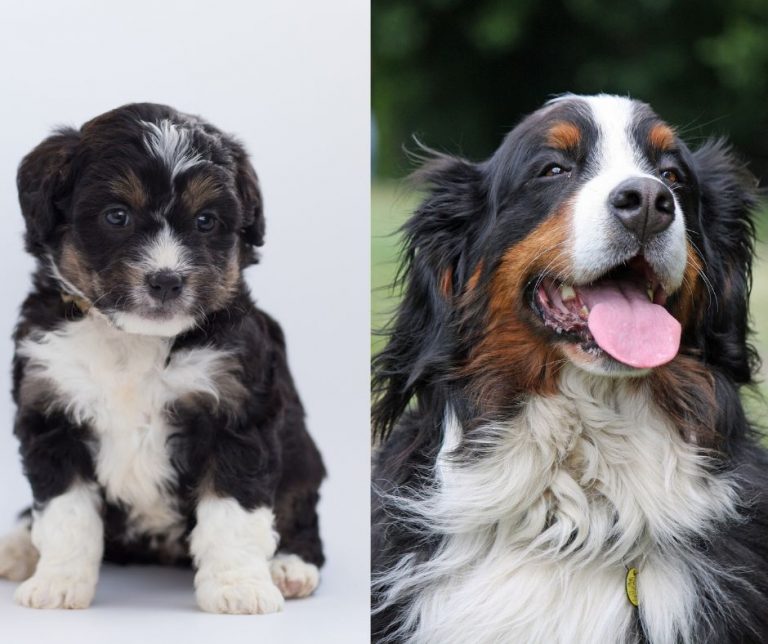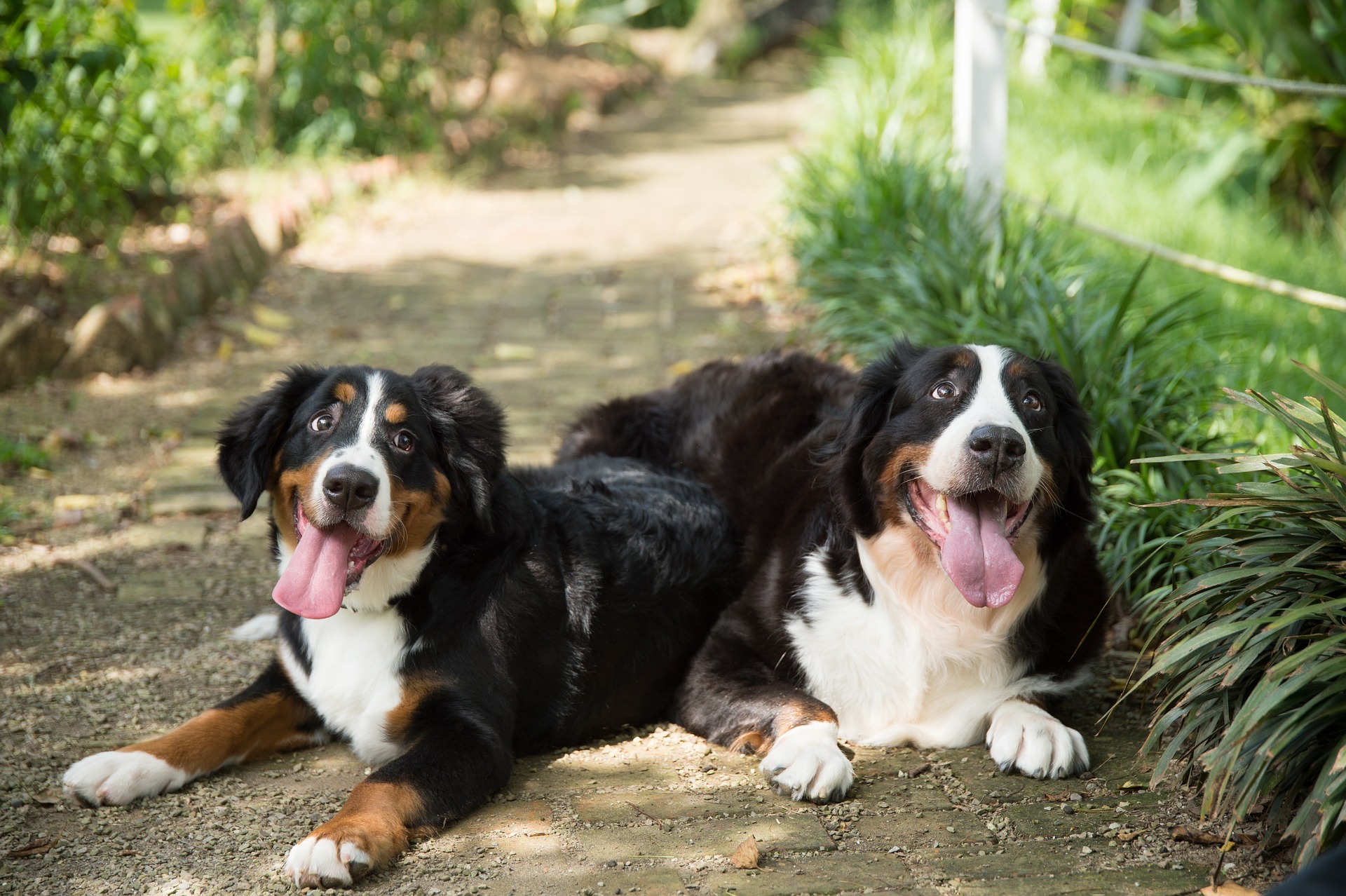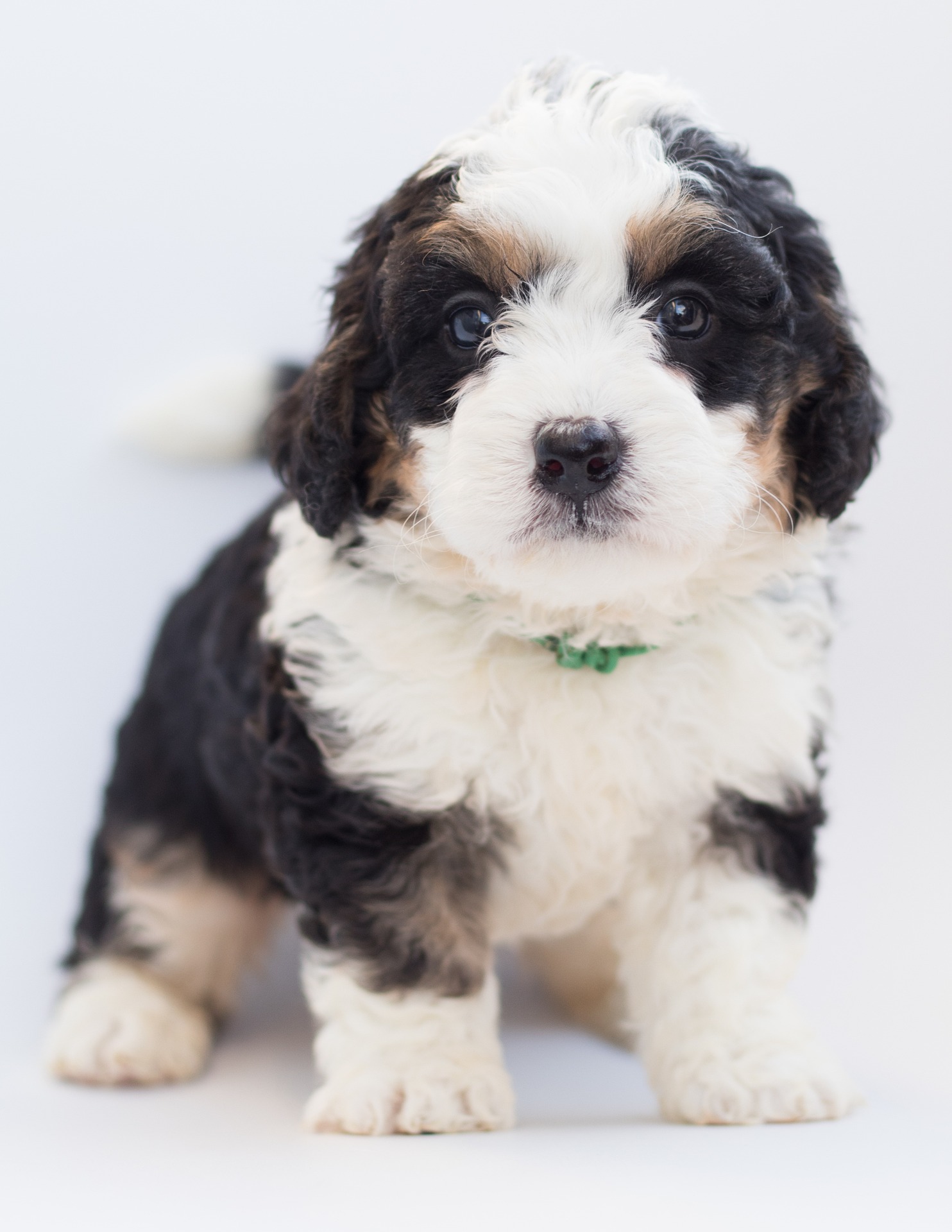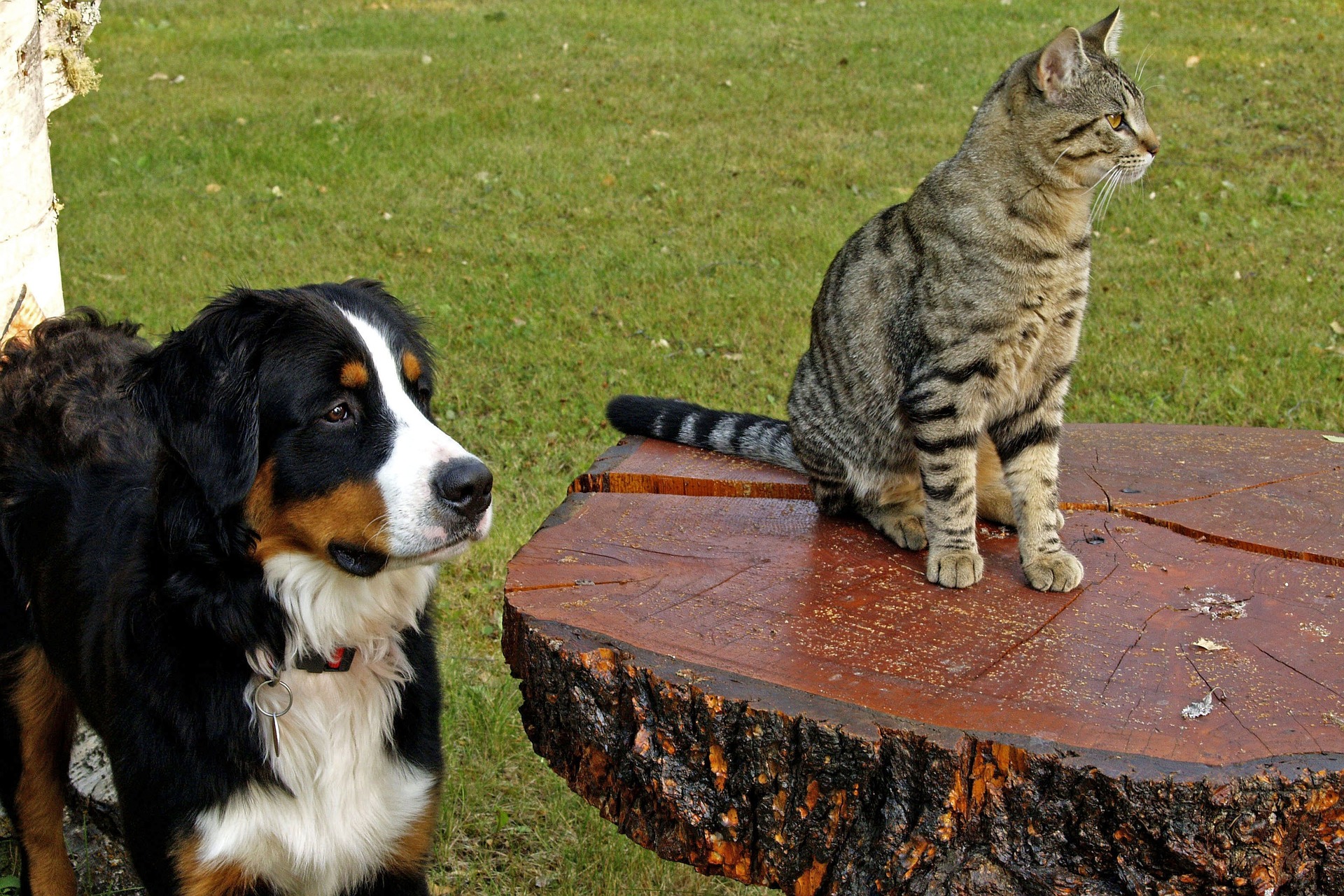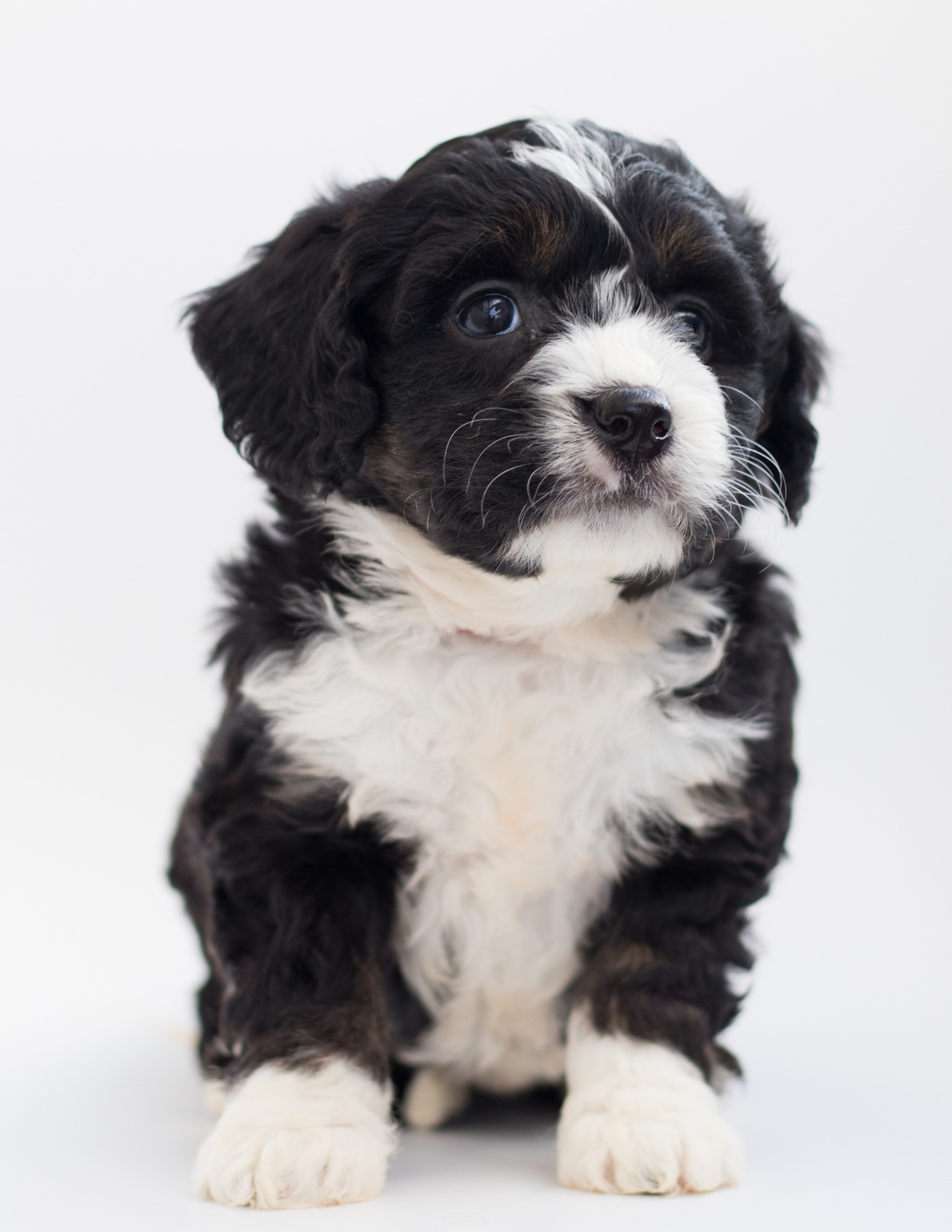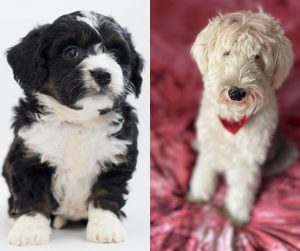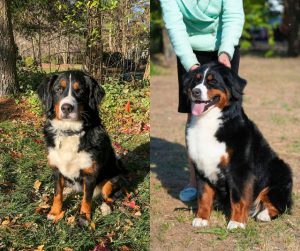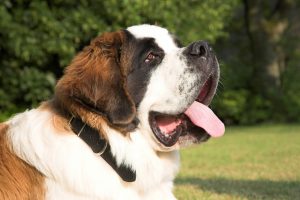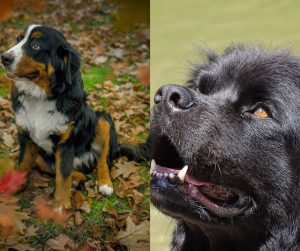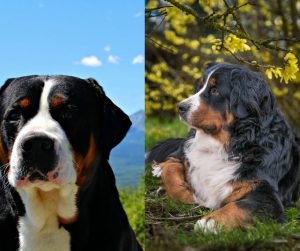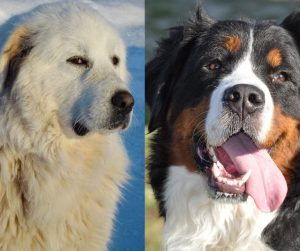When considering a fuzzy addition to the family, the playful Bernedoodle and the majestic Bernese Mountain Dog often capture hearts. Both breeds share a lineage with the intelligent and endearing Poodle. The Bernedoodle dog breed is a direct crossbreed, while the Bernese Mountain Dog was mixed historically centuries ago.
With plush coats, soulful eyes, and an abundance of love to give, these dogs are more than just pets; they’re companions for life. Yet, despite these commonalities, significant differences in their physical attributes, maintenance needs, and personalities make each breed unique.
Understanding the nuances between the two can significantly sway a potential pet owner’s decision.
The Bernedoodle inherits the hypoallergenic coat of the Poodle and comes in varied sizes, making it a versatile choice for various households. On the other hand, the Bernese Mountain Dog boasts a robust frame and a heart to match, with a gentle demeanor that belies its size.
They demand more space and have distinct exercise needs that are integral to their well-being.
When choosing between the two, prospective owners must consider not only the striking visual differences but also the contrasting characteristics intrinsic to each breed, impacting the way they integrate into daily life and routines.
Let’s go ahead and compare dog breeds, Bernedoodle vs Bernese Mountain Dog.
Key Takeaways
-
- Bernedoodles and Bernese Mountain Dogs have distinct temperaments and maintenance needs
- Physical size and living environment suitability vary between the two breeds
- They both require dedicated training, socialization, and care to thrive
Breed Origins and History
When one thinks of companionship and loyalty, both the Bernedoodle and Bernese Mountain Dog readily spring to mind. Yet, their journeys to becoming beloved pets began quite differently.
Let’s explore their rich histories that span from Swiss origins to modern-day designer breed inception.
Roots in the Swiss Alps
The Bernese Mountain Dog has its origins nestled in the Swiss Alps, where it carved a niche as a versatile farm dog. These sturdy canines were not only cherished for their company but also for their practical roles in herding livestock and pulling carts. They even caught the eye of the American Kennel Club, which gave them an official nod of recognition.
Evolution of the Bernedoodle
On the flip side, the Bernedoodle didn’t grace the world until the early 2000s. Breeders aimed to blend the best traits of the Bernese Mountain Dog with those of the intelligent and playful Poodle. This hybrid breed—sometimes favoring the hypoallergenic coat of the Poodle—was tailored primarily for companionship, sparking joy in the hearts of families and those with allergies alike.
Depending on the Poodle parent, there is a Toy Bernedoodle, Mini Bernedoodle, or Standard Bernedoodle. But because pet parents often look for small dogs, we rarely see a Standard Poodle as the parent. Mini Bernedoodle is much more common.
Physical Characteristics
When comparing the Bernedoodle vs Bernese Mountain Dog, you can notice some distinct differences in their physical traits. From size and weight to their lush coats, both breeds display unique attributes that appeal to dog lovers.
Size and Weight
Bernedoodles vary widely in size. This Poodle mix can weigh between 55 and 90 pounds and stand about 21 to 29 inches tall, primarily influenced by the size of the Poodle parent they’re crossed with. The Toy Bernedoodle is the smallest one.
On the other hand, the Bernese Mountain Dog shows less variation in size, usually weighing a heftier 70 to 115 pounds and standing 23 to 28 inches tall.
Coat and Colors
The coat of a Bernedoodle can be wavy or curly, often inheriting the Poodle’s hypoallergenic fur, which is a boon for those with allergies. They might flaunt a mix of black, white, and sometimes brown in their coat.
The purebred Bernese Mountain Dog exhibits a thick double coat that keeps them warm in cold climates, typically featuring distinct black, white, and rust markings. Both breeds require regular grooming, but one may find the Bernedoodle’s fur more manageable day to day.
Temperament and Personality
When deciding between a Bernedoodle vs Bernese Mountain Dog, their distinct temperaments and personalities are important factors to consider. Both breeds are known for their affection and loyalty, but there are nuances that set them apart.
Behavioral Traits
Bernedoodles are the result of breeding a Bernese Mountain Dog with a Poodle parent breed, inheriting traits from both parents. They are typically intelligent and playful, yet they might exhibit a stubborn streak, which calls for consistent training methods.
They are often very affectionate and friendly, with bursts of energy that make them suitable for active families. The energy levels can vary, often requiring 2+ hours of exercise daily.
On the other hand, Bernese Mountain Dogs are known for their calm and gentle demeanor, often becoming loyal family companions. Their friendly nature also makes them great playmates for children, although their size should be considered around smaller kids. These dogs usually need around 1+ hour of exercise per day, making them a bit less demanding in terms of activity when compared to Bernedoodles.
Companionship and Family Life
Bernedoodles shine in their adaptability as family dogs. They tend to form strong bonds with family members, often being happy and loving toward both adults and children alike. Their sociability extends to other pets, especially when introduced properly.
On the other hand, Bernese Mountain Dogs are often very affectionate and thrive on companionship. They may require socialization to get along well with other pets, but once accustomed, they generally become loyal companions.
Both dogs fit well into family life, demonstrating loyalty and an eagerness to be included in daily activities. Their love for their families makes either breed a heartwarming addition to a loving home.
Exercise Needs and Activity Levels
When you’re trying to decide between a Bernedoodle puppy and a Bernese Mountain Dog, understanding their needs for play and activity is vital. They’re eager for fun and are bound to bring energy and joy into any household, but their exercise needs do differ somewhat.
Bernedoodle Playtime
Bernedoodles inherit a zest for life from both their Poodle parent and Bernese Mountain Dog parent. They typically require a moderate amount of exercise to stay happy and healthy. This can include:
-
-
- Daily walks: At least 30-60 minutes of walking
- Interactive play: Fetch, tug-of-war, or agility training
-
Their playful nature means they thrive on attention and creativity during playtime. Bernedoodles are adaptable, matching their energy levels with the activity at hand, and are often content with the exercise they get from structured activities and free play around the yard.
Bernese Mountain Dog Enthusiasm
Bernese Mountain Dogs are known for their high energy levels and need for more intense exercise. They benefit from:
-
-
- Longer exercise sessions: At least 1–2 hours daily of outdoor activities like hiking or running
- Consistent routine: A regular schedule helps them manage their high energy levels
- Engaging tasks: Working or pulling activities are excellent due to their heritage
-
Their enthusiasm for staying active and being outdoors should not be underestimated. A Bernese Mountain Dog’s energy needs to be channeled properly through sufficient physical activity to prevent boredom and maintain their overall well-being.
Training and Socialization
When it comes to training and socialization, both the Bernedoodle and the Bernese Mountain Dog show remarkable intelligence but may display stubbornness. Employing consistent training methods and early socialization can harness their intelligent and trainable nature while mitigating their stubborn streaks.
Early Training Tips
Training should start as early as possible with both breeds to take advantage of their teachable puppyhood. They respond well to:
-
-
- Positive Reinforcement: Reward-based training works best, using treats or praise to encourage desired behavior
- Consistency: Consistent commands and routines help both breeds understand and follow rules
-
Social Behaviors
Socialization is crucial from a young age for these dogs to develop well-rounded personalities, especially:
-
-
- Meeting New People: Introduce them to various people to promote friendly behavior
- Interacting with other Pets: Early exposure to other pets can help ensure they become sociable with fellow animals
-
Health and Lifespan
When considering a Bernedoodle or a Bernese Mountain Dog, it’s important to understand their health and expected lifespan. They both have joyful spirits but come with different health considerations and life expectancies.
Common Health Concerns
Bernedoodles and Bernese Mountain Dogs share some health concerns due to their genetic makeup. They can both be prone to hip dysplasia, a condition affecting the hip joint, and elbow dysplasia, which impacts the elbow joint. These issues can affect their mobility and quality of life.
Moreover, both breeds may be at risk for cancer, which is a notable concern for Bernese Mountain Dogs especially. Other health issues include:
-
-
- Bloat: A serious condition that can be life-threatening if not treated promptly
- Hereditary Diseases: Some diseases are passed down genetically, making regular health screenings important
-
Managing Long-Term Health
Proactive care can help manage and possibly prevent some of the health concerns associated with these breeds. Owners should consider the following:
-
-
- Regular Check-Ups: Scheduling check-ups with a veterinarian can catch and manage health issues early
- Diet and Exercise: Maintaining a healthy diet and proper exercise can help prevent bloat and keep joints healthy
- Weight Management: Keeping a dog at a healthy weight reduces the stress on joints, potentially decreasing the risk of dysplasia
-
The Bernedoodle generally has a life expectancy of 12-18 years, varying based on size. Smaller dogs typically live longer. The Bernese Mountain Dog, on the other hand, has a shorter lifespan, averaging 7-10 years. This difference is crucial for families choosing a longstanding, furry companion. Owners can be instrumental in ensuring these dogs live full, healthy lives by understanding and addressing these health considerations proactively.
Grooming and Maintenance
When deciding between a Bernedoodle and a Bernese Mountain Dog, grooming needs are a significant factor. They both have beautiful coats that require attention but differ in shedding and maintenance.
Shedding and Allergies
Bernedoodles often inherit the Poodle’s low-shedding, hypoallergenic fur, making them a preferable choice for people with allergies. Still, one must remember not all Bernedoodles are hypoallergenic, as it depends on which traits they inherit. It is also important to understand the difference between F1 Bernedoodle and F2 Bernedoodle. When your Doodle puppy is a mixed between Poodle and Bernese Mountain Dog, the chances for being hypoallergenic are 50%.
But the chances go up with F2 Bernedoodle, which is a mix between Poodle and Bernedoodle, or Bernedoodle and Bernedoodle.
On the flip side, the Bernese Mountain Dog tends to have a heavier shed. They possess a thick double coat that sheds seasonally and will likely leave more fur around the home. For allergy sufferers, this higher level of shedding might be a point of concern.
Grooming Requirements
The grooming struggle is real, and these two breeds aren’t in the same boat. Here’s what prospective pet parents are in for:
-
-
- Bernedoodles:
- Their coat can range from wavy to curly
- Regular brushing, say a few times a week, is the name of the game to prevent matting
- Professional grooming every few months can keep their coat in tip-top shape
- Bernese Mountain Dogs:
- They wear a gorgeous, long, and thick double coat
- They’ll need brushing several times a week, more during shedding seasons
- Tackling their grooming can be more of a workout due to their size and amount of fur
- Bernedoodles:
-
Adaptability to Living Environments
When picking between a Bernedoodle and a Bernese Mountain Dog, understanding how they’ll fit into your living space and react to your local weather is key. These furry friends each come with their own set of preferences and adaptabilities that can make them your perfect companion or a bit of a challenge, depending on where you call home.
Space and Living Conditions
Bernedoodles are known for their flexibility in adapting to various living spaces. They can thrive in an apartment setting as long as they get enough exercise.
However, it’s important to note that adequate daily exercise is crucial to keeping them happy and calm.
On the other hand, the Bernese Mountain Dog, with its larger size, typically prefers a home with more space, ideally with a yard where they can stretch their legs and lounge about.
Both breeds are family-friendly, and they do well in homes where they can be part of family activities. They exhibit calmness once adequately exercised, which is vital for maintaining harmony in a family living environment.
Weather Adaptations
Bernedoodles and Bernese Mountain Dogs have different coats that present unique adaptations to weather.
The Bernedoodle’s coat is typically curlier, resembling that of a Poodle, which provides them with some resistance to cold weather.
However, the Bernese Mountain Dog, with its thick, long coat, is very well-suited for cold climates. Originating from the Swiss Alps, the Bernese Mountain Dog’s coat is perfect for snowy weather.
One thing to keep in mind is that while both breeds can handle cooler temperatures, precautions should be taken during extreme cold. Protective measures such as dog sweaters or coats could be considered.
In contrast, during hotter months, both breeds require shade and plenty of water. But the thick coat of the Bernese Mountain Dog may make it more prone to overheating, so one must monitor them more closely to prevent heat-related issues.

